FORT WORTH, Texas — It was only fitting that Utah’s season would come down to balance beam.
All year long, the fourth-ranked Red Rocks have been the nation’s best team on beam.
Two weeks ago at regionals, it was Utah’s beam team that secured back-to-back wins and a trip to nationals.
So of course Utah’s season would come down to another beam performance.
Leading No. 5 Alabama by less than two-tenths of a point entering the final rotation of Thursday’s national semifinal at Dickies Arena in Fort Worth, Texas, the Red Rocks came through once again on their best event.
Led by Kara Eaker, Abby Paulson and Maile O’Keefe, Utah scored a meet-best 49.600 on beam to finish second behind No. 1 Oklahoma.
Utah finished the meet with a 197.7125, well ahead of Alabama (197.1000), which unraveled on vault at the same time Utah excelled on beam.
Results
- Team scores — Oklahoma, 198.1125; Utah, 197.7125; Minnesota, 197.1125; Alabama, 197.1000.
Event winners
- All-around — Jade Carey (Oregon State); 39.6500.
- Balance beam — Luisa Blanco (Alabama), Kara Eaker (Utah), Maile O’Keefe (Utah), Abby Paulson (Utah), Lexy Ramler (Minnesota); 9.9375.
- Floor exercise — Jordan Bowers (Oklahoma); 9.9625.
- Uneven bars — Audrey Davis (Oklahoma), Jade Carey (Oregon State), Lexy Ramler (Minnesota); 9.950.
- Vault — Jaedyn Rucker (Utah); 9.9625.
The placement behind Oklahoma secured Utah a spot in Saturday’s national final, the competition that will determine the 2022 NCAA national champion.
Utah has now made back-to-back trips to the Final Four, currently the highest stage of competition in women’s college gymnastics, and the achievement did not go unnoticed.
“Being in the Final Four for consecutive years really means a lot for the program,” Utah head coach Tom Farden said. “We are really excited for the opportunity on Saturday.”
Utah believes it has every chance to bring the national title back to Salt Lake City, too.
“Whichever team is on, it will be their day,” O’Keefe said. “I believe that.”
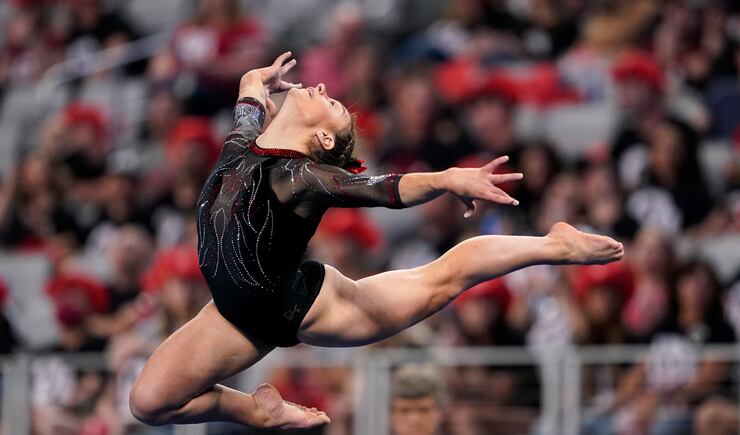
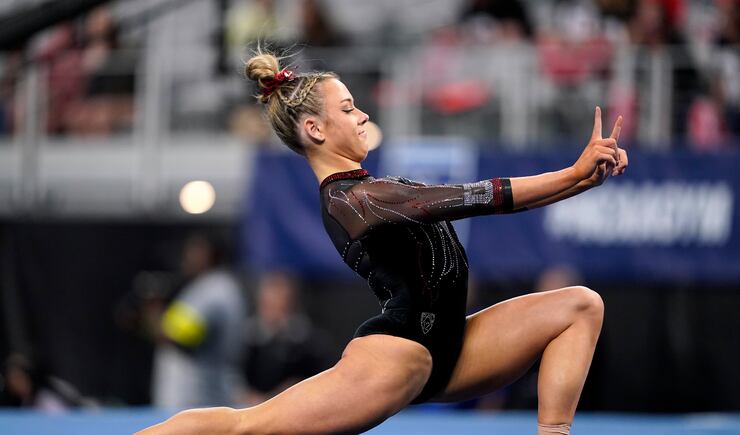
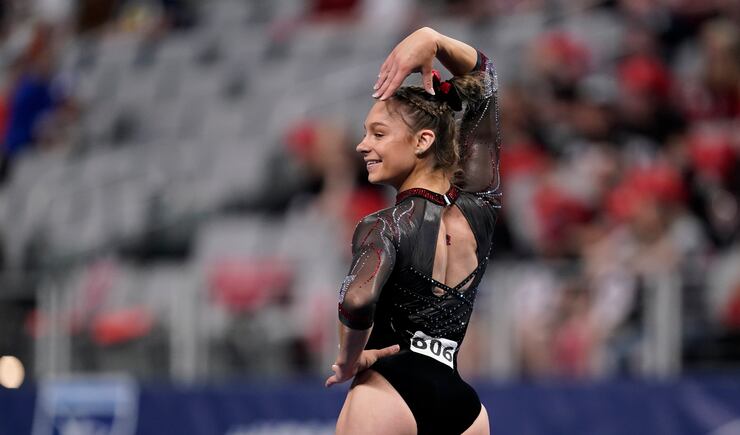
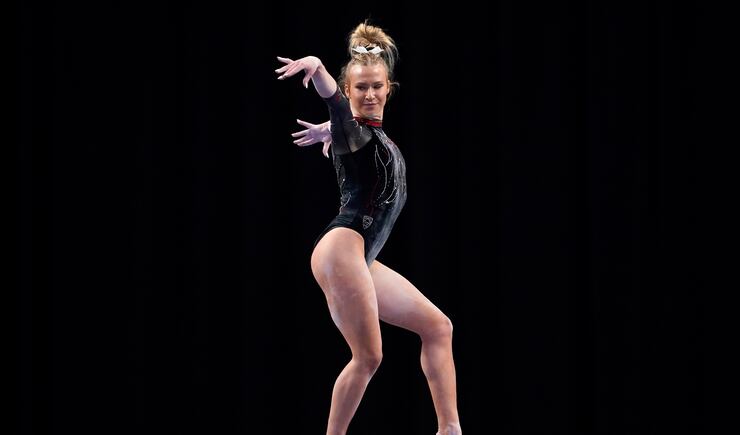
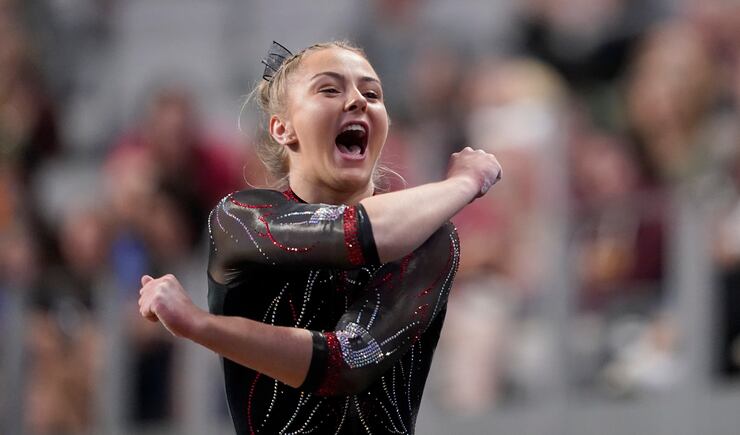
Defining moment
With as much riding on the competition as there was — it was essentially win or go home— any routine could be deemed the most important or impactful.
Any and every poor routine threatened to end Utah’s season, while every good one seemed to be the one that would prolong it.
Given the meet ended on beam, though, and in Utah’s favor no less, no moment or series of routines were more vital to the Utes than the one’s that came on their best apparatus.
Specifically three beam routines, all of which scored a 9.9375, were the difference as Utah was able to outlast both Alabama and Minnesota.
Eaker, Paulson and O’Keefe each tied for the best beam score in the meet, all impressing in their own way.
Paulson was first and her routine was a comeback of sorts, as she was injured before the Seattle Regional and only competed on floor once over two meets.
The junior hardly missed a beat in return to beam, though, and had one of her best performances of the season.
Two routines later, Eaker matched Paulson’s effort, and her performance impressed nearly every observer in attendance.
Thanks in part to Paulson and Eaker, O’Keefe’s anchor routine was unnecessary — Utah had already clinched its berth to the national final before she competed — but she nonetheless competed a routine of the caliber that she has become known for.
Making her routine all the more impressive was the fact that she nearly fell off the beam after appearing to roll her ankle badly on the landing of her acrobatic or acro series.
O’Keefe refused to fall, though, and in the end was once again arguably Utah’s best beam worker.
“That was not a normal series for me, but I was not willing to fall off the beam or even wobble,” she said. “I had to stay on. I fight for every turn I take.”
O’Keefe and Farden both credited Utah’s success on beam to assistant coach Carly Dockendorf, with O’Keefe noting that while Dockendorf might be a “hard coach,” her approach has quite obviously paid off.
“Our team really stems from Carly,” O’Keefe said. “Carly is the heart of our beam team.”
Farden wouldn’t let the conversation end, however, until he had credited his gymnasts as well.
“Those athletes are mentally and emotionally tough,” he said. “They have turned balance beam into a weapon for Utah.”
Needs work
There was a clear and obvious weakness for Utah, one that it will need to clean up if it is to genuinely compete for a national title on Saturday.
The Red Rocks’ uneven bars rotation left a lot to be desired, as half the lineup underperformed, some significantly so.
“We put the breaks on on bars if I’m being honest,” Farden said.
Utah got strong performances from Amelie Morgan, Sage Thompson and O’Keefe, but Grace McCallum, Paulson and Cristal Isa all performed beneath their capabilities.
Those routines, which included a 9.7000 and a 9.7250, opened the door for Alabama to threaten the Utes in the final rotation of the meet after Utah had established itself as the clear No. 2 behind Oklahoma midway through the competition.
It was unusual to see Utah struggle on bars. The reason why they did was anything but unusual, however.
“Athletes who are typically exceptional on bars tried a little too hard to be perfect,” Farden said. “We had to gather the team together and talk about staying in the moment and not getting ahead of ourselves.
“We need to work with that bar, get a feel for it a little more. We will tighten things up and hopefully make some improvements.”
That’s encouraging
Nothing was more encouraging for the Red Rocks than the performance of the vault team.
Throughout the season, Utah’s vault lineup had epitomized the notion of hit or miss. Some meets, Utah would have a good performance, while in other competitions almost the polar opposite was true.
Which gymnasts hit their vaults — or didn’t — varied meet to meet as well, the event standing as the team’s clear weakness entering the national championships.
On the sports’ biggest stage, though, Utah had its third-best scoring vault rotation (49.425) of the season. Given the stakes and how much harder is to record high scores with six judges on each event as opposed to two or four, it can easily argued that the Red Rocks had their best overall vault showing of the season.
It all started with O’Keefe, whose leadoff vault, per Jaedyn Rucker, set the tone for the rest of the rotation.
“It is really nice starting with Maile,” Rucker said. “Her vault is huge. Her vault is so big, so it is nice to build off that.”
Name a gymnast, any gymnast, though, and nearly all had one of their better performances of the season.
Grace McCallum and Lucy Stanhope scored a 9.8625 and a 9.8500, respectively, while Alexia Burch continued her run of postseason excellence with a 9.9250.
It was Rucker, though, almost exactly a year removed from competing the best vault of her career, who was the standout. Her 9.9625 was the best score on vault by any competitor in the meet and a long time coming.
“I felt really confident because last year I did the same thing,” Rucker said. “I knew the setup and I thought I could go out and do it. I already knew how.”
Plus, she added, “I love doing it for my team. I have them in my mind every time — just go out there and nail it.”
As for the team’s general success on the event, it all came down to letting go.
“We just thought, ‘What do we have to lose?’” Rucker said.
Farden also credited assistant coach Jimmy Pratt. Pratt arrived in Salt Lake City over the summer from Denver, the ninth assistant coach of Farden’s tenure as head coach at Utah. It took some time for his training to show in competition, but it showed Thursday.
“It takes time for coaches to develop what they want to do,” Farden said. “I can see the system Jimmy has put in place and I am really impressed.”
Up next
Utah will have the day off on Friday, before resuming competition in the national final at Dickies Arena Saturday at 11 a.m. MDT on ABC.







